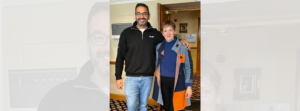Leadership Lessons – From The Horse’s Mouth
By Jo Macsween
Ever heard the expression ‘feedback is a gift’? All too often, however, we don’t receive any insightful feedback of either a positive or negative nature.
If you’re the company leader, you’ll probably receive even less than anyone else. At best you might have had a 360-degree assessment from your leadership team, and perhaps some of your board, if you have one.
But in my experience, unless you have a well thought-out and carefully facilitated process, these often-well-intended reviews can leave the people at the centre of them feeling exposed and vulnerable.
Anonymised scores and comments often lack context or offer any possibility of a meaningful, insightful conversation, which is the most productive kind of feedback.
Imagine learning the truth about how you really come across, with no axe to grind, no malice, no games, nor politics. Is this too fantastical to wish for?
However amazing we human beings are, we are after all, well, human. We’re prone to all sorts of doubts, interferences and biases that get in the way of providing honest and sincere feedback.
Now, suspend your own judgement for a minute or two
I’m about to tell you that the source of the some of the most profound feedback I’ve received in my life was, in fact, a horse. Or several horses, to be precise.
Picture an indoor equestrian arena in rural Scotland. Sand covers the floor, and there are various jumps, poles and horse-scaled obstacles lying around. I can’t imagine getting over some of these particularly elegantly myself, never mind leading a horse over or around them.
I can hear sounds of horses moving about in the stables next door; and when I inhale, various farmyard odours permeate my nostrils (some more pleasant than others).
I’m wearing multiple layers of clothing to keep warm, which are acting at as comforting, reassuring outer skin, soothing the tight knot I realise I have in my stomach.
My peer group of leaders are arriving, and the reality of the situation is becoming even more apparent. I’ve gone out on a limb here – professionally and personally.
They’re trusting my decision to bring them here, and my judgement that we will all gain leadership insights working with horses as part of our annual retreat.
But there’s one thing they don’t know
What I didn’t share is that I’m terrified of horses, and I’m hoping no one notices. I especially hope the horses don’t notice.
We do have a couple of very experienced guides for the day, including Rosalie Millard Evans, a Chartered Psychologist, who’s been delivering equine-facilitated learning programmes for years.
After setting the scene a bit in the classroom, covering our aims as well as general health and safety, we head onto the arena floor to meet our first horse of the day.
We split into two: one horse and one trainer per group. None of us will be riding or getting on a horse, and initially the first task appears deceptively simple: walk forwards with the horse using the lead rope.
Interestingly the horse’s harness and lead rope turn out to give a false sense of control. It soon becomes clear that despite lots of encouraging words from the group member (let’s call him Peter to hide his real identity), the horse seems reluctant and unsure about moving forwards. After a few failed attempts, Rosalie invites those of us in the group who are observing to share what we are noticing about the situation. She encourages us to support each other with tasks if we notice our team members having difficulties.
So, what do we notice?
We comment that perhaps more connection and trust need to be established with the horse before getting into the task itself. Rosalie offers a few tips on what might work best from the horse’s perspective, and starts to gently press her fingertips along the horse’s mane.
Soon we notice how the horse’s demeanour has shifted: it begins to lower its head and respond to her mini massage, which is clearly hitting the spot.
She invites Peter to consider how he feels about the task: “How intentional are you feeling? Have you visualised it in your mind? The horse will sense if you really believe you can do this, Peter – you need to embody the task, and demonstrate clearly the way ahead.”
Armed with this new insight, Peter has another go.
A deeper connection with the horse is established, and with a more purposeful move forwards, off they go together… for a while that is, until Peter’s concentration is lost, and the horse loses focus and interest, and wanders off in a different direction.
Peter resets again, and after a few minutes, the two make reasonable progress round the arena. I’m impressed but not entirely surprised, as this confident experimental approach is how I have encountered Peter’s leadership and personality.
I can’t get out my head, that it will soon be my turn
Maybe I should volunteer before the tasks get too complicated and I risk feeling humiliated by my comparative inability to connect with the horse and make progress.
I’m aware that my inner judge and critic is getting louder and my earlier stress is still very present. When my moment arrives, I’m surprised by being allowed to choose my task.
Trusting my instincts, I ask if can groom the horse as a means of forging my connection. After a while, my group is asked to reflect on what they are noticing is going on.
An insightful comment is offered up: “Is Jo doing for the horse what she most needs for herself at this moment? Giving some calming strokes? Some nurturing?”
I feel tears welling up in my eyes as the truth of this comment lands deep inside me. And then I’m crying. I feel very exposed for a moment – I wasn’t expecting emotions as profound as this to come to the surface.
Although I can’t find any words – and part of me really wants to turn my face away to recover my composure – I notice the horse is staying very present and connected to me.
I’m deeply moved and realise that my crying has been a welcome release of the tension I was holding. A letting go of any sort of ‘performance’ expectation I was setting for myself.
What is refreshing is that the horse isn’t passing any judgement on my tears or feeling awkward or embarrassed. Instead, I feel a great sense of liberation in being able to accept myself in the moment, just as the horse is doing for me.
My fear begins to subside, and I find myself wondering what other mirrors will be held up for me and the group today.
Moments of truth
As the day progresses, each of us faces a moment of truth as our interactions with the horses become more complex.
Often, we’re invited to consider how the situation unfolding with the horse in the arena might be showing up elsewhere in our lives, and there are many light bulb moments. What becomes clear as the day unfolds, as we all begin to relax more into the session, is that the more we allow ourselves to be playful and experimental, yet clear about our intentions, the deeper the connection with the horse becomes, and the more we’re able to achieve together.
Group challenge
The day culminates with a group challenge. We need to manoeuvre our way round the whole arena taking in various obstacles.
Our horse for this task is George. He’s not wearing a lead rope – It’s up to us as a group to ensure he chooses to come with us. If any one of us loses connection to the task, each other or to George, we’ll lose momentum and go off course.
After a few false starts, we begin to move around the arena in a more cohesive fashion. I’m struck by how far we have all come in a matter of hours.
We all arrived with our own private thoughts about the day – some of us were excited horse enthusiasts; others, like me were more apprehensive.
Now we’re gliding round the arena with George our midst as if he were one of us. Even more remarkable is that we are doing this in complete silence that no one requested or signalled.
We are calm and yet deeply connected to each other. I realise that we’ve learnt how to communicate at a profound level with the horses we have been spending the day with. We have come to appreciate more deeply that to lead effectively requires more than words or the status of job title.
Making a connection
Above all, a connection first needs to be made. For that to happen, time needs to be invested in understanding how the other ticks. Sometimes that might involve you sharing a bit of your own emotion, and that might initially make you feel vulnerable.
To be effective in the arena, we needed to be clear about our intentions, both internally and externally.
Internally, we needed to really believe in the task. Externally, we had to exude that belief and look forward at where we needed to go, before heading purposefully in that direction while still keeping a connection to the horse at all times. But not by pulling on a rope!
We needed to accept that whether we like it or not, our emotions leak out of us, however good we think our poker face is. Sometimes, I think we’ve all spent so much time in our heads that we forget we’re animals too.
Human beings – just like horses – sense misalignments all the time.
However, while a horse will give you instant, honest and accurate feedback, people usually won’t.
Often this is because it doesn’t feel safe to do so. There’s a myriad of reasons why not, but often it is due to there not being enough trust and connection established in which feedback can be safely given and received.
Instead, all sorts of de-energising dynamics arise, where people either have conversations in their own heads, or side conversations that you’d rather were out in the open.
All of this can mean leaders can’t quite work out why they have ‘staff issues’ or think something is amiss with the company ‘culture’.
Ultimately, if you want to change the conversation or culture of your company (or your personal life, for that matter), start with yourself. Spend time with a horse, you might find you get the best feedback of your life.
Related Articles
Lessons from Abrdn – why do smart leaders make mistakes?
This week’s news that the company formerly known as Standard Life Aberdeen is restoring its missing vowels got me thinking. How does a mistake like that happen at the highest levels of leadership? Back in 2021, the company’s board took a bold gamble and rebranded as “Abrdn” after a major merger, driven by the inconvenient…
ReadJoining the CEO Peer-to-Peer Coaching Group: A Journey of Growth and Connection
Jawad Jumani – known as JJ – is Managing Director of Livingstone International Ltd which specialises in the sourcing and manufacture of bespoke clothing and accessories for customers and clients based in the UK, Europe, Africa and North America. JJ has been a member of Jo’s peer-to-peer leadership coaching group for almost 6 years and…
ReadStuck in a rut?
The latest Gallup poll* regarding employee engagement the UK could make for depressing reading with a mere 17% engaged and a whopping 83% disengaged. It can be all too easy to turn our focus on the employee and shy away from a more awkward lens – what if you are the leader and it’s you…
Read


